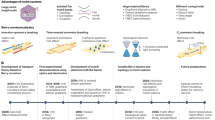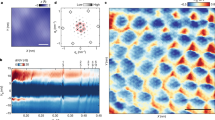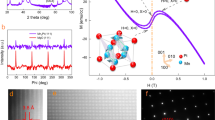Abstract
Domains are of unparalleled technological importance as they are used for information storage and for electronic, magnetic and optical switches. They are an essential property of any ferroic material. Three forms of ferroic order are widely known: ferromagnetism, a spontaneous magnetization; ferroelectricity, a spontaneous polarization; and ferroelasticity, a spontaneous strain. It is currently debated whether to include an ordered arrangement of magnetic vortices as a fourth form of ferroic order, termed ferrotoroidicity. Although there are reasons to expect this form of order from the point of view of thermodynamics1, a crucial hallmark of the ferroic state—that is, ferrotoroidic domains—has not hitherto been observed. Here ferrotoroidic domains are spatially resolved by optical second harmonic generation in LiCoPO4, where they coexist with independent antiferromagnetic domains. Their space- and time-asymmetric nature relates ferrotoroidics to multiferroics with magnetoelectric phase control2,3,4,5 and to other systems in which space and time asymmetry leads to possibilities for future applications.
This is a preview of subscription content, access via your institution
Access options
Subscribe to this journal
Receive 51 print issues and online access
$199.00 per year
only $3.90 per issue
Buy this article
- Purchase on Springer Link
- Instant access to full article PDF
Prices may be subject to local taxes which are calculated during checkout






Similar content being viewed by others
References
Dubovik, V. M. & Tugushev, V. V. Toroid moments in electrodynamics and solid-state physics. Phys. Rep. 187, 145–202 (1990)
Fiebig, M. Revival of the magnetoelectric effect. J. Phys. D 38, 123–152 (2005)
Eerenstein, W., Mathur, N. D. & Scott, J. F. Multiferroic and magnetoelectric materials. Nature 442, 759–765 (2006)
Katsura, H., Nagaosa, N. & Balatsky, A. V. Spin current and magnetoelectric effect in noncollinear magnets. Phys. Rev. Lett. 95, 057205 (2005)
Mostovoy, M. Ferroelectricity in spiral magnets. Phys. Rev. Lett. 96, 067601 (2006)
Ginzburg, V. L., Gorbatsevich, A. A., Kopayev, Y. V. & Volkov, B. A. On the problem of superdiamagnetism. Solid State Commun. 50, 339–343 (1984)
Ascher, E. Some properties of spontaneous currents. Helv. Phys. Acta 39, 40–48 (1966)
Gorbatsevich, A. A. & Kopaev, Y. V. Toroidal order in crystals. Ferroelectrics 161, 321–334 (1994)
Sannikov, D. G. Ferrotoroic phase transition in boracites. Ferroelectrics 219, 177–181 (1998)
Schmid, H. On ferrotoroidics and electrotoroidic, magnetotoroidic and piezotoroidic effects. Ferroelectrics 252, 41–50 (2001)
Ederer, C. & Spaldin, N. A. Towards a modern theory of toroidal moments in bulk periodic crystals. Preprint at 〈http://xxx.lanl.gov/abs/0706.1974v1〉 (2007)
Ascher, E. Kineto-electric and kinetomagnetic effects in crystals. Int. J. Magn. 5, 287–295 (1974)
Kimura, T. et al. Magnetic control of ferroelectric polarization. Nature 426, 55–58 (2003)
Hur, N., Sharma, P. A., Ahn, J. S., Guha, S. & Cheong, S.-W. Electric polarisation reversal and memory in a multiferroic material induced by magnetic fields. Nature 429, 392–395 (2004)
Lottermoser, T. et al. Magnetic phase control by an electric field. Nature 430, 541–544 (2004)
Arima, T. et al. Resonant magnetoelectric x-ray scattering in GaFeO3: observation of ordering of toroidal moments. J. Phys. Soc. Jpn 74, 1419–1422 (2005)
Kornev, I. et al. Magnetoelectric properties of LiCoPO4 and LiNiPO4 . Phys. Rev. B 62, 12247–12253 (2000)
Popov, Y. F. et al. Magnetoelectric effect and toroidal ordering in Ga2-x Fe x O3 . J. Exp. Theor. Phys. 87, 146–151 (1998)
Ascher, E., Rieder, H., Schmid, H. & Stössel, H. Some properties of ferromagnetoelectric nickel-iodine borate, Ni3B7O13I. J. Appl. Phys. 37, 1404–1405 (1966)
Newnham, R. E. & Redman, M. J. Crystallographic data for LiMgPO4, LiCoPO4 and LiNiPO4 . J. Am. Ceram. Soc. 48, 547 (1965)
Vaknin, D., Zarestky, J. L., Miller, L. L., Rivera, J.-P. & Schmid, H. Weakly coupled antiferromagnetic planes in single-crystal LiCoPO4 . Phys. Rev. B 65, 224414 (2002)
Santoro, R. P., Segal, D. J. & Newnham, R. E. Magnetic properties of LiCoPO4 and LiNiPO4 . J. Phys. Chem. Solids 27, 1192–1193 (1966)
Kharchenko, N. F., Kharchenko, Y. N., Szymczak, R., Baran, M. & Schmid, H. Weak ferromagnetism in the antiferromagnetic magnetoelectric crystal LiCoPO4 . Low Temp. Phys. 27, 895–898 (2001)
Rivera, J.-P. The linear magnetoelectric effect in LiCoPO4 revisited. Ferroelectrics 161, 147–164 (1994)
Fiebig, M., Pavlov, V. V. & Pisarev, R. V. Second-harmonic generation as a tool for studying electronic and magnetic structures of crystals: review. J. Opt. Soc. Am. B 22, 96–118 (2005)
Fiebig, M., Lottermoser, T., Fröhlich, D. & Kallenbach, S. Phase resolved second harmonic imaging with nonideal laser sources. Opt. Lett. 29, 41–44 (2004)
Bauer, E. et al. Heavy fermion superconductivity and magnetic order in noncentrosymmetric CePt3Si. Phys. Rev. Lett. 92, 027003 (2004)
Figotin, A. & Vitebskiy, I. Electromagnetic unidirectionality in magnetic photonic crystals. Phys. Rev. B 67, 165210 (2003)
Acknowledgements
We thank the Collaborative Research Center (SFB) 608 and the Priority Program (SPP) 1133 of the DFG and the Swiss NSF for subsidy, and R. Boutellier and S. Gentil for help with growing the crystals. We further thank C. Ederer and N. A. Spaldin for many discussions. M.F. thanks T. Elsässer for continuous support. H.S. is indebted to E. Ascher for initiating him into the realm of symmetries and into the importance of the time-odd polar vector.
Author information
Authors and Affiliations
Corresponding author
Ethics declarations
Competing interests
The authors declare no competing financial interests.
Supplementary information
Supplementary Notes
The file contains Supplementary Notes consisting of two parts: (1) Supplement 1: Absence of ferroelectricity and ferroelasticity in LiCoPO4. In this text the possibility of ferroelectricity and ferroelasticity in LiCoPO4 is discussed. It is shown that neither form of ordering can be applied as alternative explanation for the domain structures denoted as ferrotoroidic. In addition, experimental data confirming the absence of ferroelectricity and ferroelasticity in LiCoPO4 are reported. (2) Supplement 2: Derivation of 2’ symmetry from SHG data. In this text it is shown that the 2’ symmetry of LiCoPO4 in the spin-ordered phase can be derived from the set of polarization contributions to the SHG signal alone if only the crystal structure and the presence of a weak magnetization is taken into account. (PDF 108 kb)
Rights and permissions
About this article
Cite this article
Van Aken, B., Rivera, JP., Schmid, H. et al. Observation of ferrotoroidic domains. Nature 449, 702–705 (2007). https://doi.org/10.1038/nature06139
Received:
Accepted:
Issue Date:
DOI: https://doi.org/10.1038/nature06139
This article is cited by
-
Investigation on electrical and magnetic properties of BiFeO3–SmFeO3 solid solution
Journal of Materials Science: Materials in Electronics (2024)
-
Electrical switching of ferro-rotational order in nanometre-thick 1T-TaS2 crystals
Nature Nanotechnology (2023)
-
Manipulation of nonlinear optical responses in layered ferroelectric niobium oxide dihalides
Nature Communications (2023)
-
Ultrafast terahertz emission from emerging symmetry-broken materials
Light: Science & Applications (2023)
Comments
By submitting a comment you agree to abide by our Terms and Community Guidelines. If you find something abusive or that does not comply with our terms or guidelines please flag it as inappropriate.



